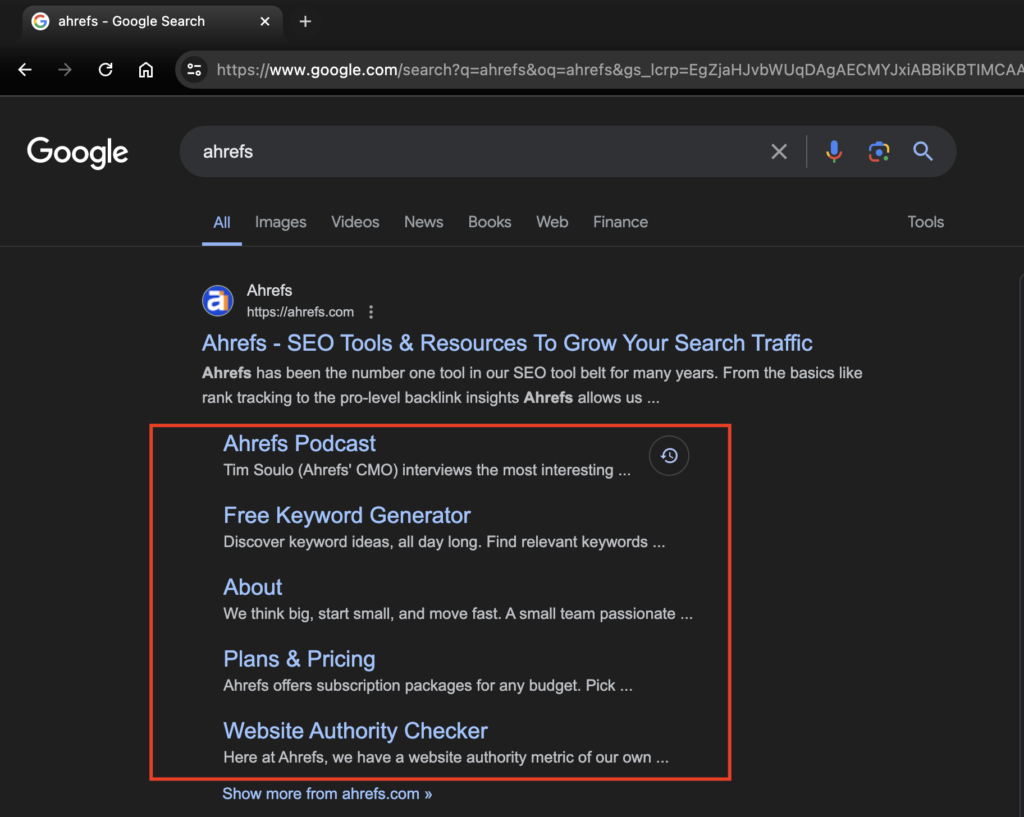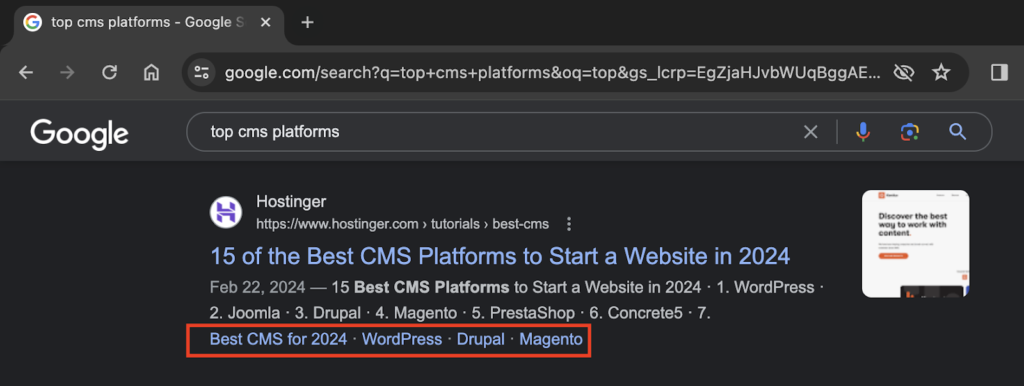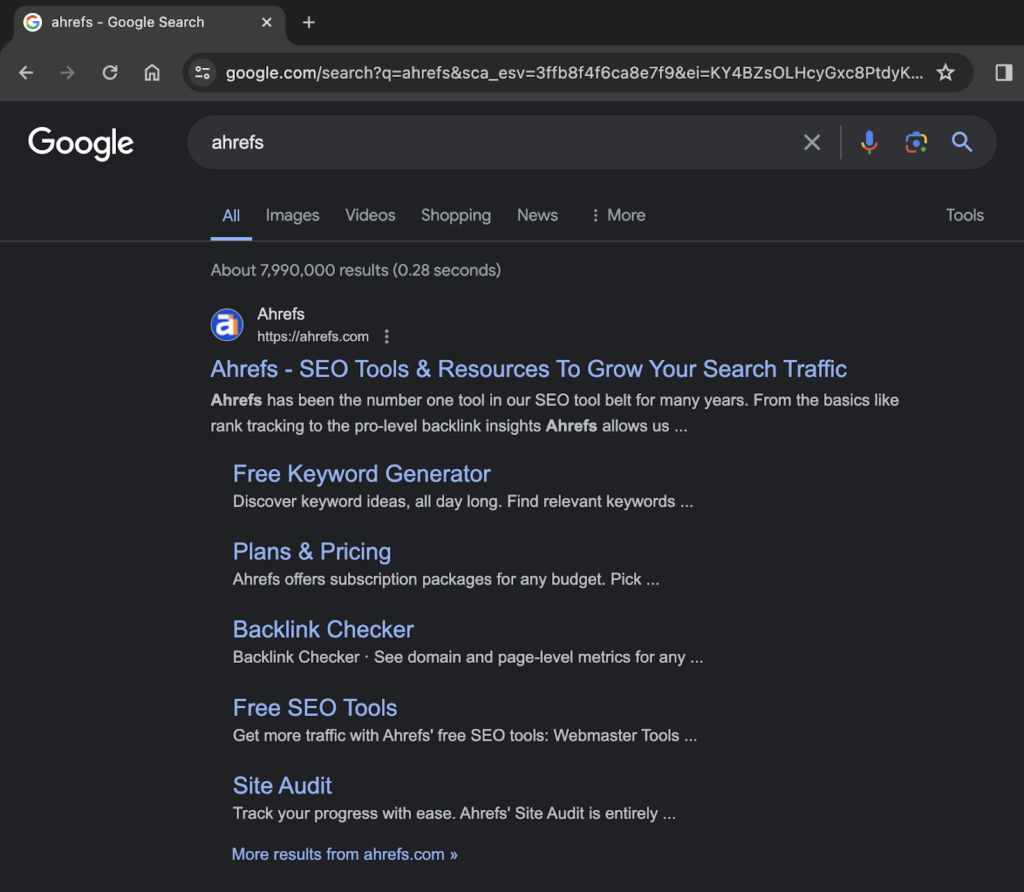Latest update: April 24, 2025
Sitelinks, those additional links beneath your site’s search results, are not just navigational shortcuts; they are strategic tools that can enhance visibility, improve user experience, and significantly increase click-through rates.
With a focus on leveraging these powerful elements to their fullest potential, we aim to unravel the best practices that can transform your online presence. By understanding how to utilize site links effectively, businesses can ensure that their most important pages are directly accessible from the search results, thereby streamlining the user journey and highlighting key aspects of their offerings. As we embark on this exploration, remember that the ultimate goal is to provide users with the most relevant and useful information, ensuring a seamless and rewarding online experience.

What Are Sitelinks?
Sitelinks are a dynamic feature in digital marketing and SEO that serve as additional links beneath the main website link in search engine results pages (SERPs). They offer users a shortcut to specific, often visited pages within your site, such as contact information, product pages, or FAQs, directly from the search results, enhancing user experience and site navigability. Trusted sources like Google’s Search Central Blog highlight their significance in directing traffic more effectively through a streamlined navigation path.
How Many Sitelinks Can You Have?
The number of sitelinks displayed can vary depending on several factors, including the search query’s relevance to your site and the device being used. Typically, Google can show up to six sitelinks for desktop searches and up to eight for mobile searches. However, the actual number presented is at Google’s discretion, aiming to provide the most user-friendly experience possible.
How to Get Sitelinks in Google Search Results?
- Ensure your brand name is optimized for search ranking. This involves incorporating your brand name strategically throughout your website’s content, metadata, and URLs to enhance its visibility in search engine results pages (SERPs). Utilize relevant keywords associated with your brand to improve its chances of ranking higher in organic searches;
- Design a site structure that is clear and intuitive for users.Organize your website in a logical hierarchy, with easily accessible navigation menus and categories. Ensure that visitors can find what they’re looking for quickly and easily, reducing bounce rates and improving user experience, which can indirectly benefit your search rankings;
- Ensure essential pages are linked directly from the homepage. Directly linking important pages like product/service offerings, contact information, and about us sections from the homepage improves both user experience and search engine crawlability. This ensures that these critical pages receive adequate attention from search engines and users alike;
- Craft compelling titles and descriptions for key site pages. Write unique, descriptive, and engaging titles and meta descriptions for each page, incorporating relevant keywords naturally. Compelling titles and descriptions not only attract clicks in SERPs but also signal to search engines the relevance and quality of your content;
- Utilize internal linking to highlight important content to Google. Internal linking helps establish a hierarchy of importance within your website and distributes link equity throughout your site. By strategically linking to important pages from within your content, you can guide search engine crawlers to prioritize crawling and indexing those pages;
- Incorporate sitelink candidate pages into your sidebar. Utilizing the sidebar for sitelinks provides easy access to important pages directly from every page of your website. This improves navigation for users and enhances the accessibility and visibility of key pages for search engines, potentially leading to sitelinks being displayed in SERPs;
- Include a table of contents with in-page links for lengthy articles. For lengthy articles or guides, a table of contents with in-page links allows users to navigate quickly to the sections they’re interested in. This improves user experience and encourages users to spend more time on your page, potentially reducing bounce rates and signaling to search engines the quality and depth of your content;
- Implement technical and on-page SEO optimizations across your website. This involves various optimizations such as optimizing page speed, ensuring mobile responsiveness, fixing broken links, optimizing images, and employing schema markup. Technical and on-page SEO optimizations help improve your website‘s overall performance, user experience, and visibility in search engine rankings.
How to Change Sitelinks in Google Search?
Altering sitelinks in Google Search isn’t as direct as in Google Ads since they are automatically generated based on Google’s algorithms. However, ensuring your site’s structure is clear, and that important pages are easily accessible can influence your sitelinks. Regularly updating your site’s content and using structured data can also help Google understand which pages are crucial to your site’s purpose.
Types of Sitelinks
There are several variations of sitelinks, including:
Inline Sitelinks

Smaller links placed in a single line beneath the main search result.
Expanded Sitelink Groups

Larger blocks of sitelinks with additional detail that can include up to two lines of description for each link.
Mobile Sitelinks

Direct links to specific parts of a website, often seen in mobile searches.
Each type offers unique benefits, catering to different user needs and search contexts.
Best Practices for Sitelinks
To maximize the effectiveness of your sitelinks, consider the following best practices:
- Ensure Relevance: Link to pages that offer significant value and relevance to your audience;
- Update Regularly: Keep your sitelinks updated with the most current and useful pages;
- Optimize for Mobile: With mobile searches on the rise, ensure your sitelinks lead to mobile-friendly website;
- Utilize Descriptive Text: Use clear, action-oriented text for your sitelink descriptions to entice clicks;
- Monitor Performance: Regularly review the performance of your sitelinks in Google Ads to optimize for the highest engagement.
| Practice | Description | Benefit |
|---|---|---|
| Ensure Relevance | Link only to pages that are highly relevant to your ad or search snippet. | Increases user engagement and click-through rates. |
| Update Regularly | Regularly review and update your sitelinks to reflect your site’s most current and useful pages. | Keeps your links fresh and relevant to users. |
| Optimize for Mobile | Ensure that your sitelinked pages are optimized for mobile users. | Enhances user experience on mobile devices. |
| Utilize Descriptive Text | Use clear and action-oriented text for your sitelinks to encourage clicks. | Improves the click-through rate by providing clarity. |
| Monitor Performance | Regularly assess the performance of your sitelinks and adjust strategies accordingly. | Allows for continuous optimization of sitelinks. |
How Sitelinks on Impact on User Experience?
Sitelinks significantly enhance the user experience by simplifying navigation and reducing the steps needed to reach high-value pages. By presenting users with a snapshot of a website’s core pages directly on the search engine results page (SERP), sitelinks facilitate a smoother, more intuitive browsing experience. They allow users to bypass the homepage and directly access the information or products they are interested in. This directness not only improves user satisfaction but also can decrease bounce rates and increase the time spent on the site.
Furthermore, sitelinks allow businesses to highlight specific aspects of their offerings, such as special promotions or popular categories, thus guiding the user’s journey toward desired outcomes. Optimally configured sitelinks act as a concise menu, making the digital storefront more accessible and inviting, which is particularly beneficial for mobile users who desire quick and easy navigation.
Sitelinks and SEO
Sitelinks play a crucial role in SEO by increasing the real estate a website occupies on a SERP, thereby improving its visibility. This increased visibility often leads to higher click-through rates, as users are more likely to select a result that provides multiple pathways to relevant information. Additionally, the presence of sitelinks can be an indicator of a website’s authority and relevance to search engines, which can positively influence its overall ranking. However, it’s important to note that sitelinks are generated algorithmically, based on website structure and content’s relevance to search queries.
Thus, SEO professionals must ensure that their site architecture is logical and that key pages are well-optimized and easily accessible. Implementing clear, descriptive titles and meta descriptions can also aid in the generation of meaningful sitelinks, further enhancing the synergistic relationship between sitelinks and SEO efforts.
Conclusion
As we conclude our deep dive into the world of sitelinks, it’s evident that these small yet mighty links hold immense potential for enhancing your website’s performance in search results. The journey from understanding what sitelinks are to effectively implementing and optimizing them requires a strategic approach, attention to detail, and a commitment to continuous improvement. By adhering to the best practices outlined in this guide, marketers and SEO professionals can ensure that their sitelinks not only improve the visibility of their site but also contribute significantly to a superior user experience, guiding visitors to their most valuable pages efficiently.
Remember, the digital landscape is constantly changing, and so are the algorithms that determine the appearance and functionality of sitelinks. Staying informed about the latest developments and being willing to adapt your strategies accordingly is paramount. Embrace the power of sitelinks as part of your comprehensive digital marketing strategy, and watch as they contribute to achieving your online goals, from increased engagement to higher conversion rates. With the insights provided in this guide, you’re now equipped to leverage sitelinks to their full advantage, setting your site apart in the vast expanse of the digital universe.


